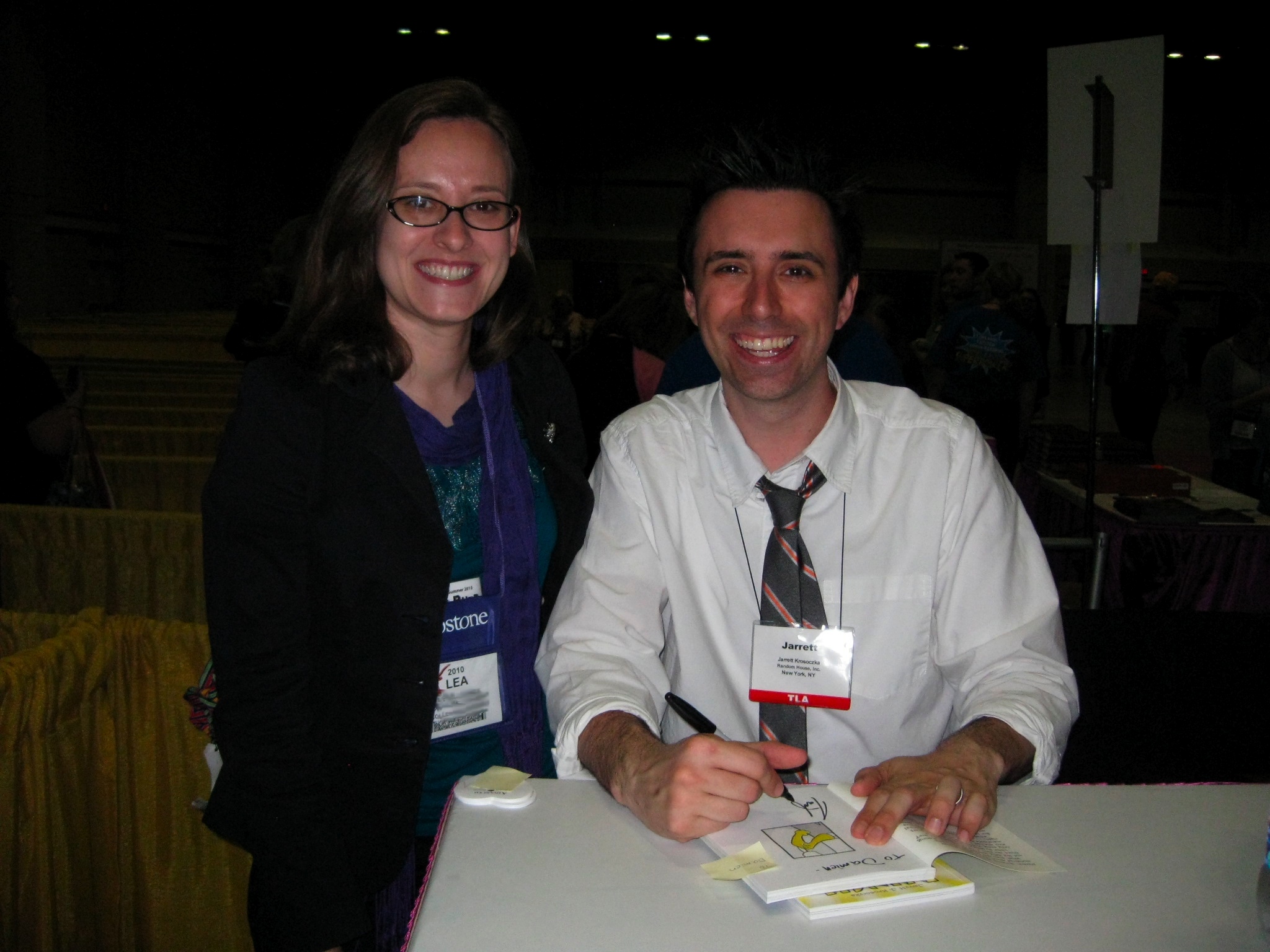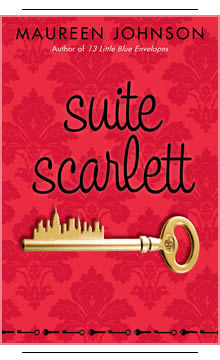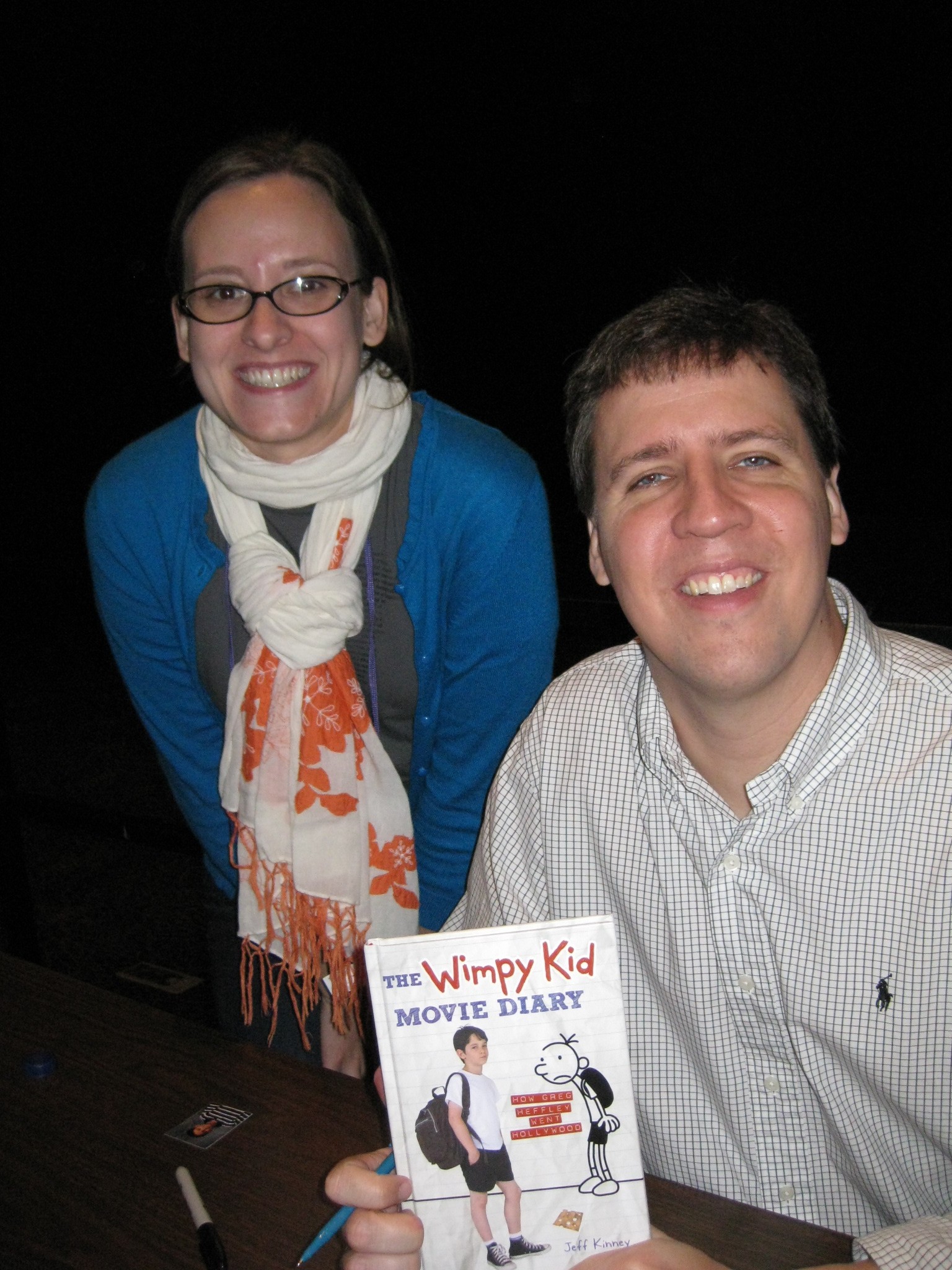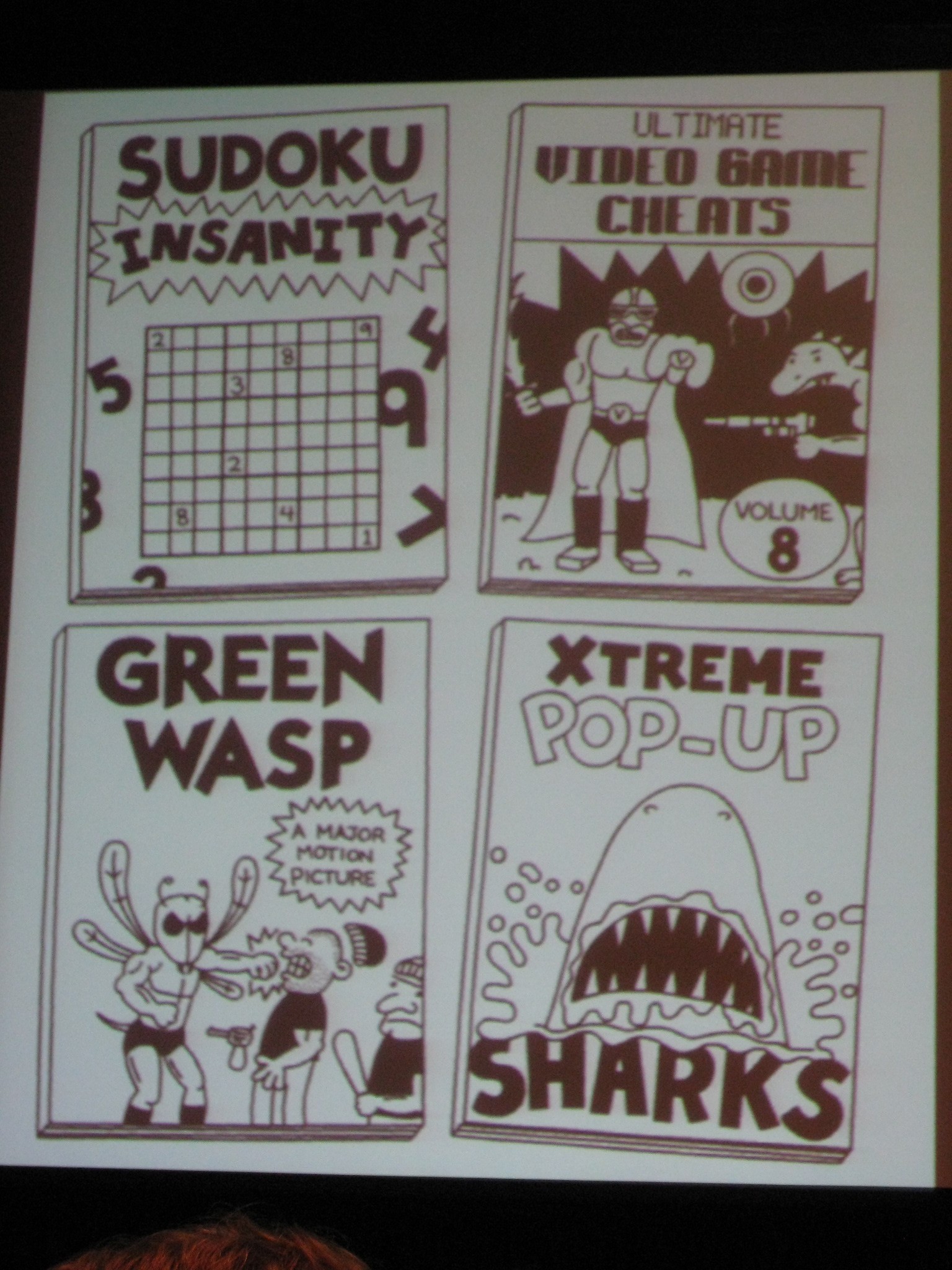Ok, so I guess I didn’t post a lot while at TLA. Instead I learned things, had talented people write their name on things, ate tasty things, got rain soaked, and danced until way past my bedtime.
Here is a rundown of days 2 – 4.
Day Two
Opening Session featuring Scott Simon
I love public radio. I listen to public radio for many hours a day and subscribe to many public radio podcasts. I squealed when I saw that Scott Simon was on the program. He did not disappoint. He was his signature blend of humor and heart. Fantastic.
This conversation between Scott Simon and one of his daughters is amazing.
ANimated Tutorial Sharing Project (ANTS): A Repository of Tutorials for Libraries
I started out with a presentation from the A.N.T.S. folks – Animated Tutorial Sharing Project. Those are four words I love, smooshed together into a happy, open-source, learning sandwich. A.N.T.S. does a bunch of cool stuff. They create tutorials – and encourage others to join them (like you, no, really, you). Currently I don’t have any tutorials on the class guide I maintain, even though I always embedded video during job interviews where I was required to make a LibGuide. I wonder if the usage numbers will change at all if I put an Academic Search Complete tutorial on the class guide page.
How Do We Stack Up? Outcomes-Based Assessment for Library Instruction
Next I attended a session entitled “How do we stack up? Outcomes-based assessment for library instruction” by the aforementioned Megan Oakleaf. (Megan’s PPT as a PDF and handout as a .doc file). I know everyone talks about assessment. It seems that’s what ALL of our sessions have been about lately, BUT Megan’s take is fantastic and capitalizes on information that we already have available. She emphasizes the things we can learn without having to conduct additional surveys. Instead of asking students if the library session they attended helped them create a good bibliography, look at the bibliographies they turned in.
She’s not anti survey, but thinks that in order to conduct effective assessment we need to think triangulation. Surveys, tests (measuring recall) and reviewing the work they turned in. Each strategy will result in a different perspective and different types of information, and will provide a more comprehensive picture than surveys alone (or tests alone, or assignment review alone). The three don’t need to be done simultaneously and instead can be a three-semester cycle.
Finally, Megan’s overall theme is that we have to do something with our results. Assessment that doesn’t result in change is useless. Assessment and change are a never-ending cycle – or in less fatalistic terms, an iterative process. Try, test, change, try, test, change. My worst fear is that 15 years from now I will be giving the exact same library instruction session that I’m giving today. **shudder** To prevent that from happening I will dedicated myself to a phoenix-like cycle of birth, growth, fiery explosions, and rebirth.
I spent the next half hour on the exhibit floor then popped in on the book recycling session (Rags to Riches: Book Recycling for Fun, Fashion, and Furniture) and saw some super-neat cut books. It still makes my stomach churn when I see books cut up, but the presenter assured us they were not books of any value (like all those Reader’s Digest condensed books that pop up at library book sales.) Although there was a cut book made out of Carl Hiaasen’s Skinny Dip, and I have a hard time believing that wouldn’t sell at a friends’ book sale.
Hiaasen, C. (2004). Skinny dip: [a novel]. New York: Alfred A. Knopf.
Day Three
I spent a little time on the exhibit floor then headed upstairs for my first session of the day.
Shaping the Confident Freshman: Covering All the Research Bases
This one proved worthwhile in the first three minutes when our presenter, Mary W. George, did a quick show-of-hands survey of the audience which was dominated by school librarians. The large number of school librarians and Megan Oakleaf’s comment that “information literacy is a K-20 process” really made me think about what I teach, who I’m teaching it to, and who all should be involved. I’m still thinking this one through but feel like there’s something big here.
I scooted out of the session and quickly descended the stairs to secure autographs for my beloved niece and nephews.
Feeling rather peppy about my fun albeit brief convo with Jarrett Krosocka and the arc of the 4th Lunch Lady book I was ready to head out to a super-fun lunch with friends from library school.
After lunch, I decided to play public librarian for a bit and went to an author panel.
A Conversation Between Books and Technology
This one was super fun, but I also got a great writing tip that I’m going to try with article writing.
Maureen Johnson also made some incredibly-interesting points about the gendering of book covers and how e-readers can make that a non issue. She related an anecdote about an adult male reader enjoying one of her pink-covered books on his e-reader from a football stadium. This adds a neat layer of privacy in a reading-in-public-context. Although, the e-book vendor may keep a record of what you have downloaded. I keep thinking about people reading on the Metro. I was amazed by the number of people who read erotica during the commute to/from work. (Zane was rather popular.) I remember the day I was on the train reading The Carnal Prayer Mat for my Gender and Sexuality in Early Modern China class. A person across from me was looking rather intently at my book, when they looked away, I flipped it around and looked at the cover and saw for the first time that it said “Classic Erotica” across the top. Although, since the Bible was the most common reading material on the train, the person may have been pulled in by the word “prayer.” I digress . . .
Li Yu. (1995). The carnal prayer mat. Ware: Wordsworth classics.
I spent a little time talking jobs with one of my colleagues and headed back down to the exhibit floor. I still did not have one free book (except the Lunch Lady arc for my nephew) or tote bag. I left the floor to check out a colleague’s contributed paper session and headed over to the closing session.
Closing Session with Julie Powell
Before Julie Powell took the stage, the conference planners recognized sponsors and awesome librarians. I am not at all ashamed to say that I got rather teary, especially when Clara B. Mounce was given the Lifetime Achievement Award for dedicating her life to the city of Bryan, creating a collaboration between Bryan and College Station, rebuilding the library after it was intentionally set on fire, and restoring the beautiful Carnegie Library in historic downtown Bryan. Amazing.
Back to Julie Powell, I have not read Julie and Julia. I saw the first 5 minutes of the movie and fell asleep, which says nothing about the movie, I was exhausted. I have heard many things about her and went in with mixed feelings, but I found her charming, brave, and painfully confessional.
Powell, J. (2005). Julie and Julia: 365 days, 524 recipes, 1 tiny apartment kitchen. New York: Little, Brown and Co.
Robinson, A., Mark, L., Ephron, N., Goldblatt, S., Rudin, S., Lee, D. J., et al. (2009). Julie & Julia. Culver City, Calif: Sony Pictures Home Entertainment.
The floor was cleared and the stage was set for . . .
Bookcart Drill Team
I love bookcart drill team. It’s hilarious and a great way to end the week. The video I was planning on putting here has been flagged by YouTube for copyright violation which is of course being disputed by a smart and savvy librarian. We’ll see how that goes. In summary, it was very fun, and I caught a bag of peanuts. Costumes, bookcarts, and snacks – what’s better‽ (Any excuse to use an interrobang . . . )
To tide you over, here is a YouTube playlist of previous competitions.
All-Conference Reception
With most of the learning securely in the past, tucked away and waiting for the reflection and implementation phase – I headed to the All-Conference Reception to talk with friends about life, conference, libraries, and funny YouTube videos. The band was a great party cover band. All was good.
Day Four
The conference ended with a bang. I picked up my first free book and accidentally acquired two more tote bags. I checked out some databases with ABC-CLIO and won $50 from them toward my next ABC-CLIO purchase. Fun! I was talking with people in the Harper Collins free-book line and found out that you could only get Jeff Kinney to sign a book for you if you were in his session which was starting in two minutes.
The Diary of a Wimpy Kid Phenomenon: Jeff Kinney Talks About Drawing in Reluctant Readers
After running up and down the stairs a few times to ensure that I got a book signed for my oldest nephew, I breathlessly settled into my seat. I am so glad I made it. This session was an absolute delight. Jeff Kinney is absolutely hilarious. He definitely has an adult sense of humor, but was very careful as there were many children around. He didn’t say anything vulgar, he just seems to live at a PG-13 level, which shouldn’t come as much of a surprise to people who have read his Wimpy Kid books which he said he originally wrote for adults, but sees as appropriate for kids around 6th grade, although my nephew is much younger. My nephew isn’t the only young Jeff Kinney reader. When he said that he thinks his books are for a middle school audience there was a definite buzz through the crowd and head-shaking aplenty. During the Q&A a lot of librarians got up to ask questions that their students had asked them to ask Jeff. Cute.
He used a PowerPoint-like slide show full of his signature drawings to go along with his talk. It was perfect.
My favorite quote: I think Shel Silverstein is one of the greatest children’s authors or poets of all time but also a scary looking dude†Check out the 3rd Wimpy Kid book where Shel Silverstein makes a cameo of sorts.
Kinney, J. (2009). Diary of a wimpy kid: The last straw. New York: Amulet Books.
I headed back down to the floor, got a few more books and headed out of town rejuvenated and ready to get back to librarianing.






